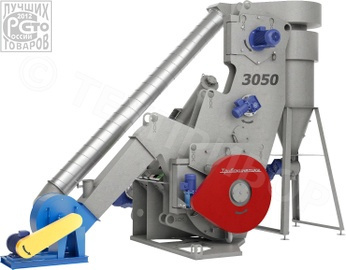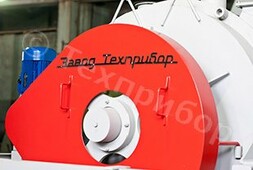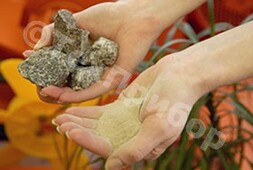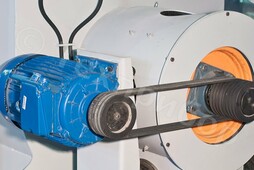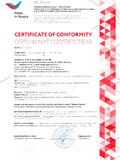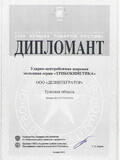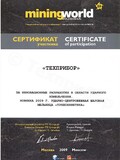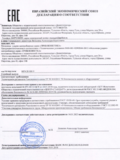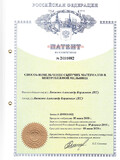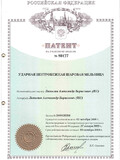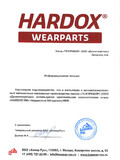General Information
The mill of TRIBOKINETIKA series, 3050 model (TU 3618-001-92992044-2012), is intended for grinding pre-dried rocks, as well as production waste with hardness of up to 8 points of Mohs scale, its capacity is 1 to 4.6 m3/h (characteristics may vary depending on the physical and mechanical properties of the raw material and required fineness).
TRIBOKINETIKA-3050 MP mill is equipped with a dynamic air-centrifugal classifier, which allows using this equipment to obtain fine powders, including D95 <45 microns.
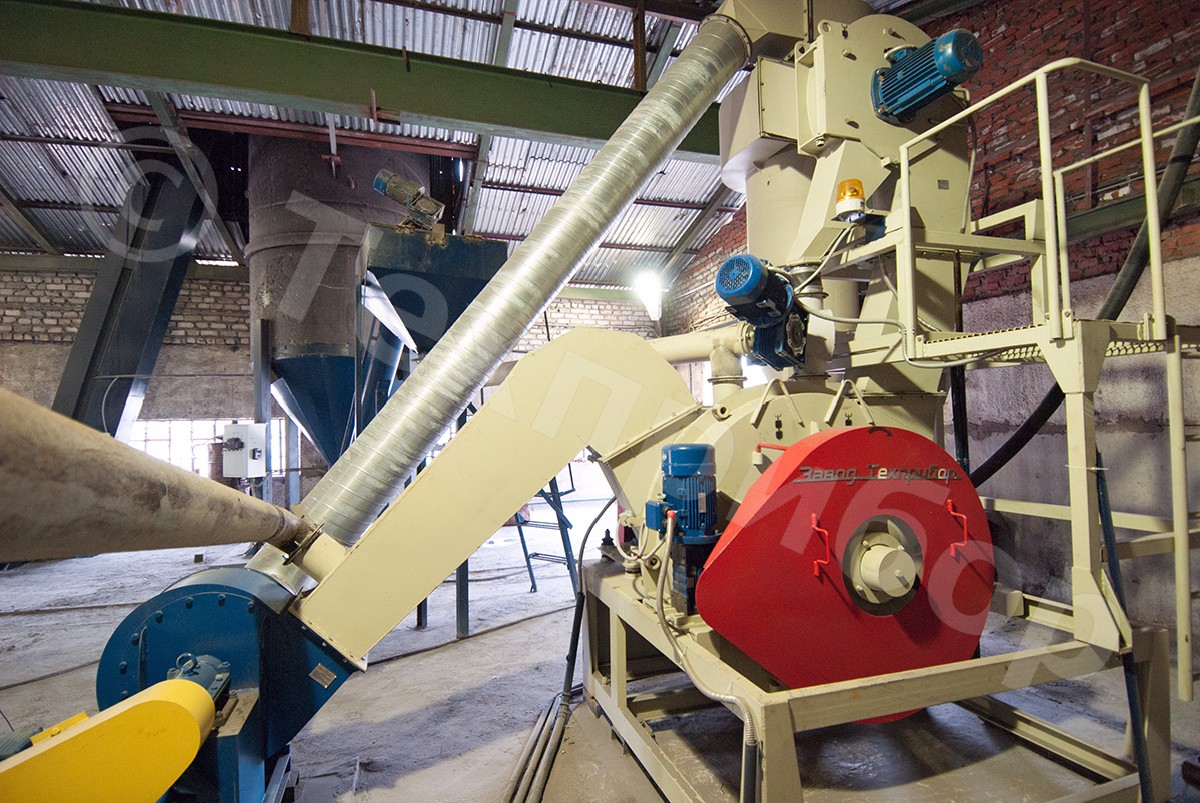
Specifications
|
|
| Parameters | Parameter value |
|---|---|
| Capacity, m3/h | 1-4.6* |
| Rated power, kW | 60.2 (64.1)** |
| Dimensions (L×B×H), mm | 5810×5476×3894 (4880)** |
| Weight, kg | 3990 (4330)** |
| Power supply voltage, V | 380 |
| Feed size, max. mm | 20 |
| Feed moisture, max. % | 1 |
Recommendations for the assessment of readiness of mills series "TRIBOKINETIKA" to launch
Mill "TRIBOKINETIKA-3050". The user manual for the "M-3050" ER. Passport "M-3050" PS
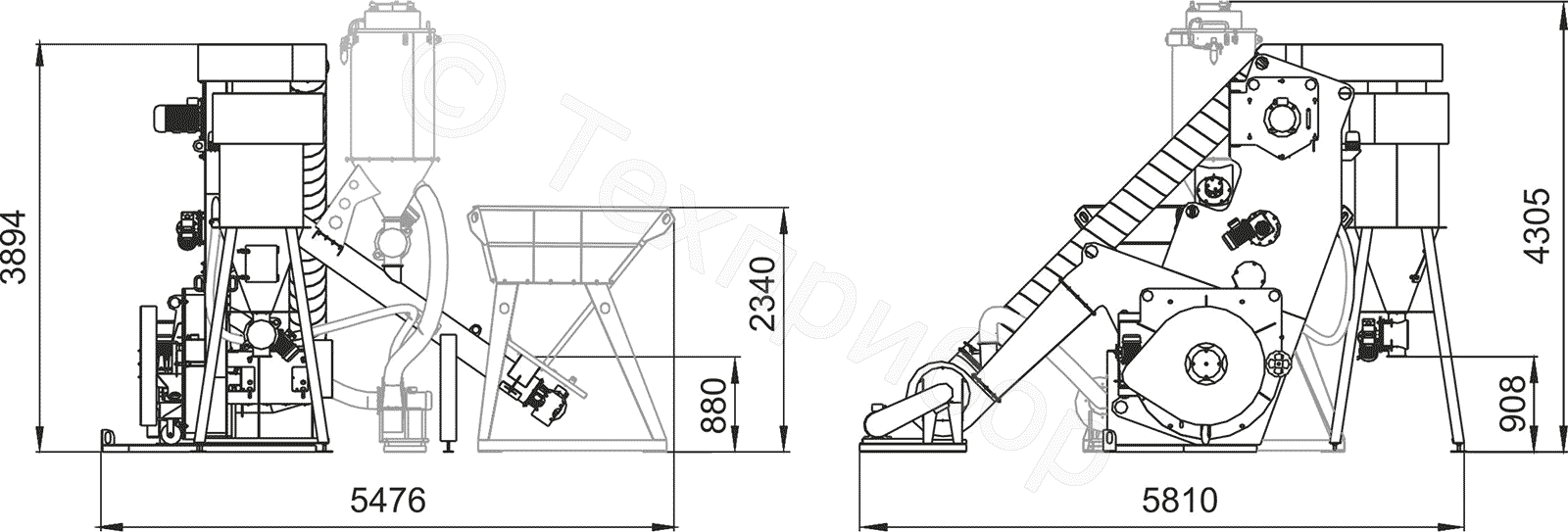
Fig.1
Unique solutions
The mill of TRIBOKINETIKA series is a new approach to the method of producing powders from mineral raw materials and industrial waste. Everything is unusual in this grinding machine, but at the same time each part of it is logical and justified, and a joint work of these parts makes the grinding process more rational, cheaper and easier. How did we achieve this? — Thanks to proprietary technical solutions and attentive attitude to the opinion of our Consumers.
If most of industrial mills crush pieces of material between their metal parts, in the TRIBOKINETIK mill, the raw material particles destroy themselves. If usually a thick armour is used to protect the equipment against wear, the TRIBOKINETIKA mill uses a self-lining principle — the protective layer is formed from the material being milled. If the process line configurations used today allow sorting the obtained powder mainly in stand-alone ponderous separators, the TRIBOKINETIKA mill classifies particles according to their size at the same time as milling. And finally, if the operation of industrial mills is possible only by specialists, in the TRIBOKINETIKA mill — this is just a press of the START button on the automatic control unit — the automatic system will perform all the critical work!
Structurally, the TRIBOKINETIKA mill is a combination of a high-speed impact deflection mill and an air-centrifugal classifier.
The centrifugal-impact method of grinding solid materials is not new; it is enough to recall the famous company “Metso Minerals” with their legendary impact crushers Barmac or the Belarusian NPO Center with KI grinding complexes. However, unlike them, the TRIBOKINETIKA mill uses a unique technical solution — the stator deflector plates rotate towards the rotor-accelerator rotation (Fig. 2).
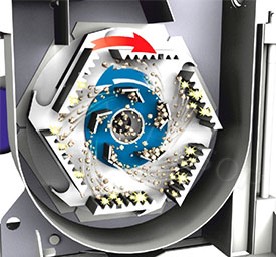
Fig.2
What does such design allow? Firstly, an increase in the impact speed, which directly effects the degree of material fineness, and secondly, an increased service life of the rotor-accelerator, since high functional speeds are summarized from lower speeds of the parts rotating towards each other.
In the TRIBOKINETIKA mill the solution of raw materials classification at the entrance is also exciting. It is well known that most types of mineral raw materials contain a certain amount of fine particles, which, getting into the grinding chamber, make it difficult to grind larger particles.
According to experts, it is precisely fine particles, which have not been promptly ejected from the process, cause increased energy consumption in the production of powders.
In the TRIBOKINETIKA mill, the raw materials are loaded into the oncoming air flow, charged by a dust-exhaust fan, small particles are immediately blown to the dynamic classifier, without falling into the grinding zone (Fig. 3).
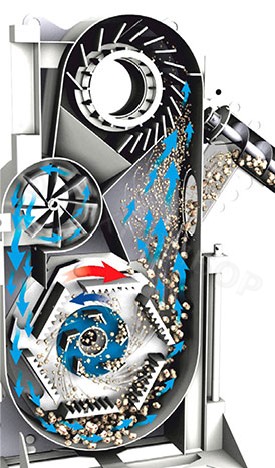
Рис.3
Given that the cost of air classification of bulk materials is usually one order lower than the cost of fine grinding and, knowing the content of particles of the required size in the raw material, it is not difficult to calculate savings of the “entrance” classification.
How does it work?
The TRIBOKINETIKA - 3050 mill is an integrated system of units compactly placed on a common base platform. The integral arrangement of the mill units (one-piece body) allow minimizing its overall dimensions, simplifying maintenance, and reducing energy consumption for production of finely dispersed powders with particle sizes of 0...0.045 mm.
The TRIBOKINETIKA-3050 mill (Fig. 4) consists of an integral body (1), an elevator block (2), located in the lower part of the mill, a rotary shutter (3) for “grit” reload – in the middle part, and a dynamic air-centrifugal classifier (4) in the upper part. On the opposite side of the body (1) there are: shock-absorbing block (5) of the rotor-accelerator, electric motor (6) of the rotor-accelerator drive, V-belt transmission housing (7), screw conveyor-feeder (8), feed hopper (9).* A cassette filter (10) * with a rotary shutter (11)* for dust reload and a small fan (12) * are located on the housing of the screw conveyor-feeder (8) *. To the right of the body (1) there are a cyclone (13) installed on supports, a rotary shutter (14) for unloading powder, transport (15) and return (16) air ducts.
To the left of the body (1) there are the main dust-exhaust fan (17) with air charging pipe (18) and excess air discharge pipe (19), a flexible sleeve (20)*. The integral body (1) is installed on the base platform (21), in the corners of the platform there are holes (22) for anchor bolts used to fix the platform on a foundation.
Operation of the electrical components of the mill is controlled from an external electrical panel with an automatic mode control unit BAU MICRON (not shown in the figure).
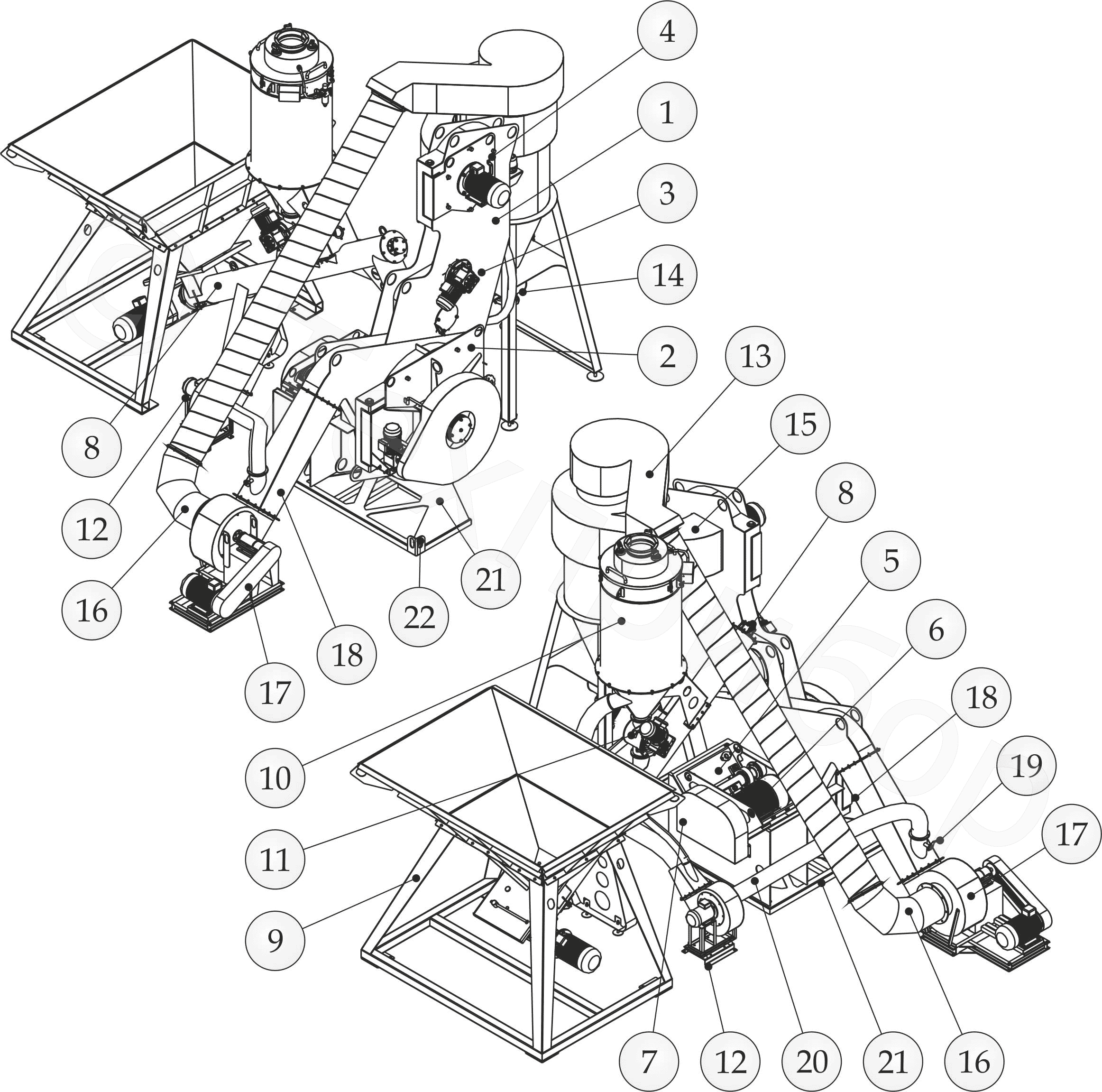
Fig.4
TRIBOKINETIKA-3050 mill (Fig. 5) works as follows: after pressing the “start” button of the automatic control unit (BAU MIKRON), the rotary shutters, the motor of dynamic air-centrifugal classifier, main dust-exhaust fan, rotor-accelerator, elevator and conveyor-feeder are sequentially started. The start of the above-listed units is accompanied by sound and light signals warning personnel about the remote start of the equipment.
A screw conveyor-feeder (8) moves the raw material into the body (1), where it is subjected to primary classification. Small particles are picked up by the air flow generated in the dust-exhaust fan (17) and sent to the dynamic air-centrifugal classifier (4). Particles, the sizes of which exceed the set cut-point size are deflected by the vanes of the guiding device and go to the grinding chamber for additional grinding.
Particles, the sizes of which are smaller than the set cut-point size pass the classifier and enter the cyclone (13) through the transport duct (15). In the cyclone, under centrifugal forces, the air flow is separated from the processed material particles, which are collected in the conical part and are discharged from the mill through the shutter (14).
The air flow, after separation from particles of material, leaves the upper part of the cyclone and enters the main dust-exhaust fan (17) through the return duct (16). Then the air cycle closes.
The excess air entering the pneumatic system of the mill along with the raw material is discharged through the nozzle (19) and via a flexible sleeve (20)* it enters the small fan (12)*, then into the cassette filter (10)*, where it is cleaned from dust.
Large particles of raw materials, which cannot be picked up by the oncoming air flow during the initial classification, fall into the grinding chamber. The elevator vanes scoop up large particles of material and move them into the center of a rotating rotor-accelerator. Large particles are accelerated and thrown to the deflector plates, which are mounted on the elevator and rotate together with it in a direction opposite to the rotor-accelerator rotation. As a result of the impact large particles of material are destroyed to smaller fragments which are picked up by the air flow and sent into the classifier (4). In this case, undestroyed particles of the material pass through the gaps of the deflector plates inside the grinding chamber again, where they are scooped again by elevator vanes. Grinding cycles are repeated until large particles of material are completely destroyed, and their fragments are taken by air flow into the classifier (4).
During the mill operation, the body (1), the transport and return ducts (15, 16), the cyclone (13) and the screw conveyor-feeder (8) stay under exhaustion.
During operation of the mill, the main controlled parameter is the current load of the electric motor of rotor-accelerator drive. An increase in the volume of raw material causes an increase in the load on the electric motor. Conventional mills, if overloaded (for example, due to an operator oversight), stop when thermal or current protection trips, and the restarting of a “jammed” mill takes a lot of time and effort. This does not happen with the TRIBOKINETIKA – 3050 mill! Its operation is constantly monitored by an automatic control unit – BAU MIKRON, which continuously controls the actual current load and timely changes the amount of loaded raw materials. As a result, the mill works at maximum efficiency level, but without overload!
* this equipment is not included in the standard delivery package of the mill
Advantages
Low energy consumption for producing fine powders, an intelligent automated work control system, long service life of replaceable parts, dust-free operation and low noise level – all this is not a complete list of competitive advantages of the TRIBOKINETIKA - 3050 mill. Find out more about them:
Large grinding capacity. The basic way of crushing mineral raw particles in the TRIBOKINETIKA - 3050 mill is a dynamic "autogenous" self-grinding. Large particles ejected by the rotor-accelerator play the role of grinding bodies, destroying smaller particles. It is traditionally believed that in order to increase the grinding capacity of impact mills, it is necessary to increase the rotor speed, however, it entails reducing the rotor service life. The abrasive wear of the rotor is especially significant when working with mineral materials of high hardness. The TRIBOKINETIKA-3050 mill uses an original method of counter-rotation of the rotor-accelerator and stator deflector plates, as a result their speeds are summarized. This solution allows to obtain a high particle collision accelerations at a relatively low rotor-accelerator speed.
Power consumption is lower. The TRIBOKINETIKA-3050 mill uses the technology of quick ejection of the required particle sizes from the process. The loaded raw material is subjected to preliminary classification already at the entrance to the grinding chamber (“the first stage separation“). Timely selection of “fine” particles allows avoiding formation of “over-crushed” classes, reducing the unproductive circulation of “dead smalls”.
Ability to work both in the “open” and in the “closed” cycles. Depending on the selected operation mode, TRIBOKINETIKA-3050 mill is capable to obtain not only fine powders, but also fractionated sands (dust-free “grit”).
The service life of replaceable elements is higher. One of the features of the centrifugal method of strong rocks destruction is an effect of self-lining of the most loaded elements of the mill with a layer of the material being ground. Self-lining, for sure, is the most cost effective protection against wear, because the material that creates such protective layer does not need to be bought, it is always enough in the TRIBOKINETIKA-3050 mill!
Operation without noise and dust. The air flow system of TRIBOKINETIKA-3050 mill operates in a partially closed cycle and reuses the main air flow, so the discharge of air into the aspiration system usually does not exceed 10% of the total turnover. During operation, all units of the mill are under exhaustion and therefore they do not emit dust.
All critical functions are done by automatic system. In standard configuration TRIBOKINETIKA - 3050 mill is already equipped with an automatic control system BAU MIKRON. BAU MIKRON provides start and stop of the mill units in the given sequence, control of emergency conditions, adjustment of the volume of loaded raw materials depending on the current load of the rotor-accelerator. The operation of the TRIBOKINETIKA-3050 mill under the control of BAU MIKRON can be characterized as highly productive, and without overloads. The sadly remembered “human factor” is a thing of the past!
Our customer assistance program: “Try before you buy”
Our automated milling complexes TRIBOKINETIKA are capable to process a wide range of materials. In various enterprises throughout Russia they are operated to grind: fly ash from thermal power plants, lump lime, cement, quartz sand, limestone, dolomite, gypsum, ceramics, carbon black, scrap of mica and even chrome ore. However, the list of raw materials is huge, same as our professional interest in grinding them. In order to give our potential Customers an experience in impact grinding of their materials by TRIBOKINETIKA - 3050 mill, we have created a testing workshop where the equipment manufactured in TECHPRIBOR factory operates under the free trial grinding program.
Fill out a simple questionnaire, send samples of your raw materials to our address, but rather come yourself — together we will surely find the best solution to process your materials.
Try to surprise us with raw materials that we have not yet milled!
Patents and Certificates
The machines of TRIBOKINETIKA series were awarded with the diploma of “100 Best Goods of Russia” program in 2012.
The machines of Tribokinetika series were recognized by rewards of international exhibitions.
In the impact-centrifugal mills-classifiers of the TRIBOKINETIKA series the original wear-resistant HARDOX 500 steel is used.
 The TRIBOKINETIKA-3050 mill complies with the requirements of Technical Regulation of Customs Union TR CU 010/2011 “On the Safety of Machines and Equipment”. (Declaration of conformity EAES No. RU Д-RU.МО10.В.04608 dated. 15.01.2018.)
The TRIBOKINETIKA-3050 mill complies with the requirements of Technical Regulation of Customs Union TR CU 010/2011 “On the Safety of Machines and Equipment”. (Declaration of conformity EAES No. RU Д-RU.МО10.В.04608 dated. 15.01.2018.)
The design of the machine is protected by RF patents No. 2411082, No. 80127.
